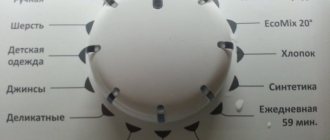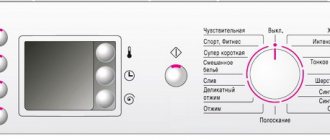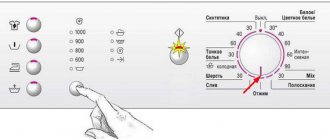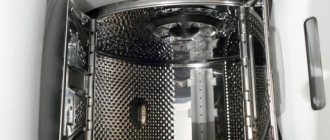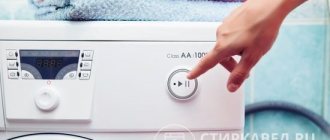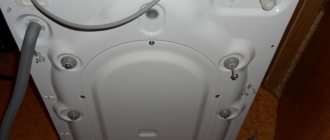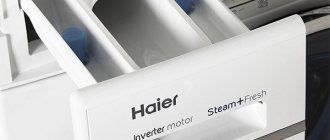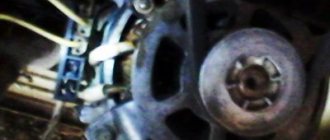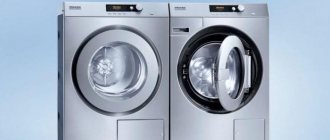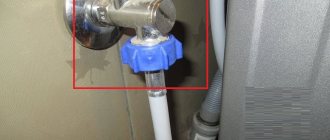Home > Manufacturers > Whirlpool > Whirlpool CMA: manuals, errors, programs
Whirlpool washing machines are reliable and easy to use. They are multifunctional and easy to use. They have modes for delicate washing, washing wool, accelerated programs, washing sports shoes and many others.
The Whirlpool washing machine, the instructions for which are posted on our website, looks great in the interior, it is stylish and beautiful. This household appliance is very reliable and has child protection.
Whirlpool machine history
The Whirlpool machine started out in America, but is now produced in many other countries. For example, in Italy they produce mainly narrow format machines, in Slovakia – vertical ones. It began to be produced in Russia in 2009, combining American quality and Russian assembly.
When purchasing a washing machine, each buyer is provided with operating instructions in several languages. It offers information to be read in small fonts and this is not always convenient. Therefore, below is all the necessary information from the instructions for using the washing machine. You need to take time and study it in order to prevent possible breakdowns and extend the operating time of your purchase.
Difficulties and ways to overcome them
Difficulties that you may encounter when disassembling the Whirlpool washing machine:
- in order not to confuse the bolts that secure different elements, they need to be laid out on sheets of paper and the corresponding signatures made; matchboxes are also suitable for this purpose;
- when connecting the control board, there is a risk of mixing up the terminals, which can cause damage to household appliances - to prevent this from happening, the wire layout must be recorded on your phone;
- some bolts may come out of the thread with difficulty; if they are rusty, they need to be treated with lubricant;
- if after assembly any of the elements do not work, it is necessary to check the tightness of the contacts;
- To avoid stripping the threads, do not apply excessive force; the bolts must be secured securely, but without force.
Modes of use
The Whirlpool washing machine has many necessary and convenient washing modes. For the convenience of Russian-speaking users, they are written in Russian, with degrees indicated next to them.
Cotton mode
From the name it is clear that cotton clothes are washed using this mode. Washing is carried out at a temperature of 90 to 95 ° C, but it can be changed if necessary. Removes even tough dried dirt. The spin is delicate. Washing lasts from 110 to 165 minutes.
Synthetics
In this mode you can wash different fabrics, temperature from 30 to 60 °C. Wash in 85-100 minutes.
Wool mode
Current mode for the cold season. Gently washes sensitive wool or cashmere items. The spin is weak. Time – 45 minutes.
Delicate
Its properties are similar to wool. This mode is used to wash delicate fabrics: lace, silk, etc. The washing temperature is low – only 30 °C. Clothes don't get damaged. Spin is minimal or absent. The process takes 45 minutes.
Pre-mode
Involves soaking. If you have to deal with very dirty clothes, you should wash them first in this mode, and then wash them mostly. Soaking lasts 20 minutes.
Daily
The mode is intended for any (except capricious) clothes that are worn every day. The process is carried out at 40 °C. From 85 to 120 minutes operating time.
Express mode
Quick wash, takes about 30 minutes.
Eco mode
The name speaks for itself. Washing is carried out on low heat, which saves light consumption. This does not affect the quality of the wash in any way.
The mode is selected on the control panel. The program and temperature are set using the rotary selector. Additional functions are activated when you press the keys. The operating time depends on the selected program.
Add powder
The quality of washing largely depends on the detergent. It may be a powder, liquid or gel substance. It is very important to correctly fill or pour the selected chemical into the equipment.
All Whirlpool washing machines have a powder receptacle or dispenser. It is located on the top left and is needed for dosing the powder. The dispenser is divided into three main compartments. It is necessary to remember the purpose of each compartment and not confuse them in the process:
- the rightmost one is used for pre-soaking (when the laundry being loaded is in a very dirty state);
- conditioner is poured into the middle one (with a removable plastic element), softening the fabric and giving it a pleasant aroma;
- the left one is needed for powder (the volume of the product depends on the volume of things and is indicated on the package).
In order for water and detergent to flow in a timely manner and in sufficient quantity, the dispenser needs to be washed regularly. With poor care, the container very quickly becomes clogged, clogged and even covered with fungus. As a result, the laundry begins to smell unpleasant.
It’s easy to fix this problem: take out the powder receptacle, soak it in a solution of citric acid or soda, rinse with water and put it back in. But it would be correct not to bring the part to such a state. After the cycle is completed, leave the dispenser open to dry and immediately remove any remaining powder.
Other features
The Whirlpool washing machine has many additional functions that improve the quality of washing clothes and items made from any fabric.
- “Drum balancing” is designed to distribute the laundry evenly.
- "Foam Control" allows you to remove foam for better rinsing.
- “Child lock” blocks the control panel of the washing machine.
- "Antibacterial" involves steam treatment for deeper cleansing.
- The “sixth sense” function determines the weight of clothes. This is necessary for automatic cycle intensity and duration.
- "AquaStop" protects against leakage by closing the valves.
- “Delayed start” involves setting a timer to start washing. For example, you can set the start to start at night to save energy. Or you can put it on in the morning, timing it so that the washing is finished by the time you get home.
- “ZEN” here washing is carried out on a low spin, however, this does not affect the result of the process.
- “Colors 15°” is recommended for colored fabrics, protects against dullness and fading. Operates at low temperature, which does not affect the quality of washing.
Other designations
There are symbols whose settings are allowed to be changed. These include manual or quick wash, cold water, economy wash, rinse and spin process.
Sources:
https://cosmo-frost.ru/stiralnye-mashiny/rezhimy-stirki/rezhimy-stirki-i-programmy-Whirlpool-opisaniya-znachki/ https://stiralkainfo.ru/stirka/rezhimy-i-vremya-stirki- v-stiralnoj-mashine-Whirlpool.html
Whirlpool washing machine error codes
There are two criteria by which Whirlpool washing machines indicate that they are faulty:
outdated samples provide signals with a specific configuration of light bulbs
modern samples display error codes on the screen
With information on what each error displayed means, you'll be ready to fix it, or worst case, report the problem to a technician.
Code F01
The reason is that little or no water enters the washing device. There are many reasons, as well as solutions, such as:
- insufficient pressure in the pipes being installed - normalize the pressure in the pipes,
- the water supply tap is closed or partially open - open the tap completely,
- the filter is clogged - clean the filter,
- failure of the water level sensor of the washing machine - fix the sensor or replace it with a new one,
- lack of contacts on the pressure switch - cleaning the contacts,
- failure on the control board - replace the broken part of the board.
F02
AquaStop:
- various types of leaks in the hydraulic system - get rid of the leak, replace broken parts with new ones,
- blocking of the water filling solenoid valve - replace or repair the valve,
- There is a problem with the electrical controller - fix the problem or install a new electrical controller.
F03
No water drainage:
- there is a blockage in the drain system - clean all drain lines,
- faulty water drain pump - fix or replace the pump,
- parts of the electrical controller are burnt out - fix them or replace them completely.
F04 F05
Water does not heat up:
- failure of the temperature sensor or its parts of the washing machine - fix individual parts that led to the failure, or completely replace the temperature sensor.
Above were examples of codes that make it clear that the washing machine is broken. For more detailed information, please use the instructions.
Removing the filter and draining the remaining water
Page 9
- Image
- Text
70
REMOVING THE FILTER
DRAINING THE REMAINING WATER
1. Turn off the machine and drain the water (see
See the next section “Draining the remaining water”).
2. Open the filter cover using a coin. 3. Place a tray or container under the lid. 4. Slowly turn the filter counterclockwise
arrows without unscrewing it completely (to simplify the operation, hold the filter clamp with pliers).
5. Wait until all the water has completely drained. 6. Now unscrew the filter completely and remove
his.
7. Remove all foreign objects from the filter. 8. Check that the pump impeller
rotated freely.
9. Insert the filter and tighten it clockwise
arrow all the way.
10.Pour 1/2 liter of water into the detergent drawer
products and make sure that water does not leak through the filter.
11.Close the lid. Check and clean the filter at least two or three times a year. • Check the condition of the filter if the device
Does not drain water properly or has problems during the spin cycle.
• Remove the filter from the machine if the pump is clogged
foreign objects (buttons, coins, pins, etc.). WARNING: Make sure the water has time to cool before draining the machine.
1. Turn off the machine. 2.Disconnect the machine from the power supply. 3.Press the drain hose connection on the rear
machine parts (see arrows A and B).
4. Place a suitable container near the machine
size.
Note: After the drain cycle, about 1 liter of water remains in the machine, but its amount can reach 20 liters if the machine is stopped while the program is running, or even 40 liters if the pump stops. 5. Place the drain hose into a container and let
drain the water.
Note: Make sure the water is cool before draining. 6.Wait until all the water has drained. 7.Reattach the drain hose to the back of the machine
(see arrow B), as otherwise there is a risk of water leakage and the normal filling and draining functions cannot be guaranteed.
8.Replace the drain hose with a U-bend and
secure it.
When should I drain the remaining water? • Before transporting (moving) the machine. • If the device is installed in a room where
Temperatures below zero are possible. In this case, the water from the machine must be drained after each wash.
2
6
4
3rus10001.fm5 Page 70 Wednesday, September 5, 2001 5:19 PM
Review of Whirlpool washing machines
There is a large selection of different models on the market, but some of them are most popular.
Whirlpool AWS 51011
This is the most budget option, price starts from 12 thousand. The machine is frontal type, has more than 15 programs, several additional functions. Loading up to 5 kg. Consumes about 40 liters. water.
AWW 61000
The most popular example of a washing machine. The cost is around 15 tons, the capacity reaches 6 kg. The power consumption class is higher.
FSCR 80414
Functionally, the latest full-size model, which contains all the functions, uses a new drum design, etc., the list can be endless. Price from 27 t.
AWO/C 7714
The model is convenient in that it is built-in. Loading up to 7 kg, all additional functions are built-in, 18 modes available. Cost about 60 thousand.
Whirlpool washing machines have received quite a lot of positive reviews. Explants praise them for their affordable cost, relatively quiet washing, as well as for their functionality and reliability. The Whirlpool machine has a reputation as a high-quality brand with a wide range of design and software features. If you are the owner of a Whirlpool washing machine or are just planning to purchase one, remember that the durability of the washing machine directly depends on care and proper use, which are described in detail in the operating instructions, as well as in this article.
